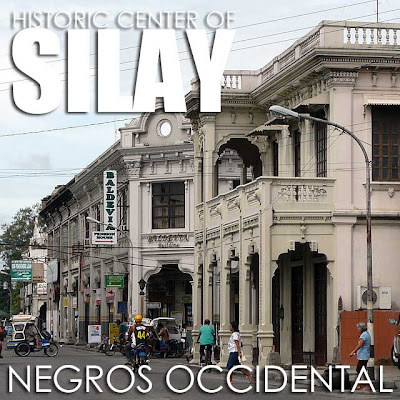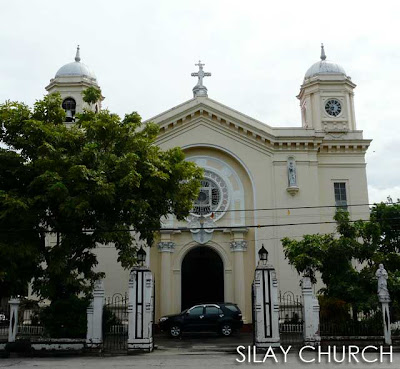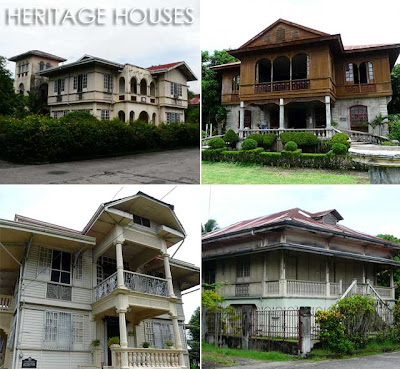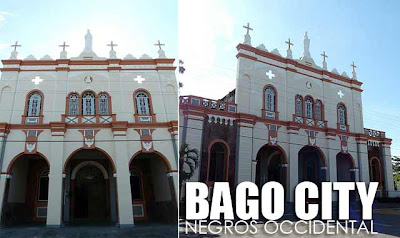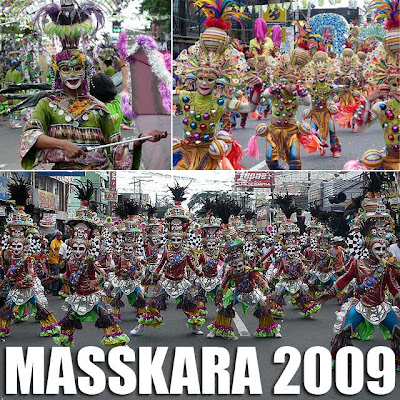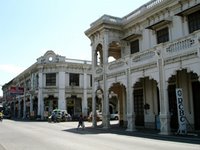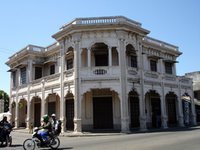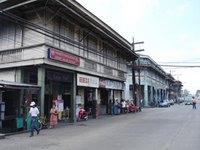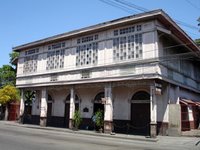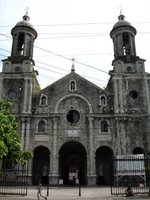 Philippine festivals
Philippine festivals or
fiestas are among the most colorful in the world! I recently got to read the book
"A Year of Festivals: A Guide to Having the Time of Your Life" published by Lonely Planet. It features the most unique festivals in the world. The first thing I did was to check how many Philippine festivals were featured.
There are five in the book, two of them in San Fernando, Pampanga! The five were the Feast of the Black Nazarene (Quiapo, Manila), Ati-Atihan (Kalibo, Aklan), San Pedro Cutud Crucifixion Rites (San Fernando, Pampanga), MassKara Festival (Bacolod, Negros Occidental) and the Giant Lantern Festival (San Fernando, Pampanga). There should have been more since the Philippines is known to be a country of colorful festivals!
That's what I've been saying about making sure festivals are unique. Festivals that cannot be found elsewhere are those which attract attention. With so many festivals and events flooding the Philippine fiesta calendar, I decided to pick my favorites from the crowd and came up with my own list of unique festivals worth visiting. Most definitely, these festivals have become iconic symbols of the towns and cities where they are held annually.
FEAST OF THE BLACK NAZARENE
January 9 | Quiapo, Manila
On this day, the centuries-old image of the Black Nazarene is pulled through the streets of Quiapo by male devotees clad in maroon, in an intense mammoth procession. This has been a tradition for over two centuries and some people who have touched the Nazarene during the procession claim that they have been healed of their diseases.
ATI-ATIHAN FESTIVAL
Third weekend of January | Kalibo, Aklan
Held every January to commemorate the feast of the Santo Niño, many consider the Ati-Atihan Festival as the
Mother of all Philippine Festivals. Among the wildest, if not the wildest of Philippine fiestas, revelers paint their faces with black soot and wear bright, outlandish costumes as they masquerade and dance in revelry around the streets of Kalibo to the beat of ambulant ethnic troubadours. This is the original street dance
fiesta of the country and many of the later street dance festivals in honor of the Santo Niño were inspired by Ati-Atihan.
The origins of the festival are said to date back to the 13th century when a group of Malay datus fleeing Borneo purchased land from the local Ati people. This agreement was commemorated with a celebration, where the datus and their people painted themselves black to honor the Ati people. This was later converted into a religious celebration with the arrival of the Spanish.
SINULOG FESTIVAL
Third weekend of January | Cebu City
The Sinulog Festival is one of the grandest, if not the grandest, and most colorful festivals in the Philippines. It is held in honor of the Santo Niño. Just like the other Santo Niño festivals, it features a street parade with participants in bright-colored costumes dancing to the rhythm of drums, trumpets, and native gongs. The day before the parade, a fluvial procession is held in the morning with the image of the Santo Niño carried on a boat from Mandaue City to Cebu City. In the afternoon, a more solemn and larger procession makes its way around Cebu City.
DINAGYANG FESTIVAL
Fourth weekend of January | Iloilo City
Another Santo Niño festival, the Dinagyang is a religious and cultural festival held the weekend after Sinulog and Ati-Atihan. The festival is also characterized by street dancing, frenetic stomping of feet to the beat of ambulant ethnic troubadours.
The festival saw its birth in the late 1960s but was just confined to a parish. It was in the 1977 when President Marcos ordered various regions to come up with festivals that would boost tourism that the Dinagyang as we know it today began to take shape. In fact, as a testament to how it has grown and evolved, Dinagyang was voted as the best Tourism Event for 2006, 2007 and 2008 by the Association of Tourism Officers in the Philippines.
 PANAGBENGA FESTIVAL
PANAGBENGA FESTIVAL
February | Baguio City
Panagbenga, or the Baguio Flower Festival, is month-long annual flower festival held in Baguio. The first one was organized in 1995. The next year, it was renamed Panagbenga, a Kankanaey term that means
"a season of blossoming, a time for flowering." The highlight of this festival is the Floral Float Parade usually held during the last Sunday of February (or first Sunday of March).
TURUMBA
April to May | Pakil, Laguna
The Turumba commemorates the Seven Sorrows of the Blessed Virgin Mary with seven
pistang lupi. The first
pistang lupi is held on the Friday before Palm Sunday (the first of two feasts of the Seven Sorrows of the Blessed Virgin Mary) and the seventh is done on Pentecost Sunday. During these days, the image of the
Nuestra Señora de Dolores de Turumba is borne on an
anda and brought around the streets of Pakil in a procession amidst dancing. Other processions are also held aside from the seven
pistang lupi, the last being on the third Sunday of September, the second feast of the Seven Sorrows of the Blessed Virgin May.
The schedule for 2009 is
Unang Lupi (
Biyernes de Dolores, April 3),
Ika-2 Lupi (
Pistang Martes, April 14),
Ika-3 Lupi (
Pistang Biyatiko, April 20, 21 & 22),
Ika-4 Lupi (
Pistang Biyernes, May 1),
Ika-5 Lupi (
Pistang Linggo, May 10), Extra
Lupi (
Pistang Pakileña, May 12),
Ika-6 Lupi (
Pistang Pag-akyat, May 22),
Ika-7 Lupi (
Pistang Pagpanaog, May 31),
Ahunan sa Ping-as (May 30), and
Domingo de Dolores (September 20).
MORIONES FESTIVAL
Good Friday |
Marinduque
A pageant of wooden masks called morion, the Moriones Festival is celebrated in the towns of towns of
Boac, Mogpog and Gasan. Men are colorfuly garbed and masked as Roman centurions. The festival culminates in the reenactment of the beheading of Longinus.
 CUTUD CRUCIFIXION RITES
CUTUD CRUCIFIXION RITES
Good Friday | San Pedro Cutud,
San Fernando, Pampanga
The San Pedro Cutud Crucifixion Rites is arguably the cultural event most visited by foreign tourists. It's mentioned in almost every guide book about the Philippines. It's actually the center of bloody flagellation practices that happen in Pampanga every Holy Week. The very first crucifixion happened in 1962 as part of a passion play of the barangay. Ever since, more and more penitents followed suit and thus began a cultural practice that went beyond ordinary flagellation.
PULILAN CARABAO FESTIVAL
May 14 | Pulilan, Bulacan
An annual festival held the day before the feast of San Isidro Labrador, it features hundreds of decorated carabaos and colorful floats parading along the streets of Pulilan, a celebration for a bountiful harvest.
 PAHIYAS FESTIVAL
PAHIYAS FESTIVAL
May 15 | Lucban, Quezon
An annual celebration to celebrate the feast of San Isidro Labrador and to usher in a bountiful harvest, homes in Lucban are decorated with the town's agricultural products. The most distinct of these decorations is the
kiping, a brightly colored rice dough rolled into thin wafers and shaped like leaves. Other decorations include fruits, vegetables, grains and straw hats.
Also visit the
Agawan sa Sariaya and
Mayohan sa Tayabas the same afternoon in the neighboring towns. The highlight of
Mayohan is the famous
agawan ng suman in honor of San Isidro Labrador.
OBANDO FERTILITY RITES
May 17 to 19 | Obando, Bulacan
A three-day festival where childless couples, praying that they bear children, do the
pandango or "fertility dance" on the streets of Obando as a procession carrying the towns patrons Santa Clara, San Pascual Baylon and the Nuestra Senora de Salambao, makes its way around town.
TAONG-PUTIK FESTIVAL
June 24 | Aliaga, Nueva Ecija
To commemorate the feast of Saint John the Baptist, the people of Brgy. Bibiclat, Aliaga, Nueva Ecija, transform themselves into mud people or
taong-putik. The ritual, called
Pagsa-San Juan, begins at dawn when devotees wear dry banana leaves or vines, smear themselves with mud and walk the streets to ask for alms in the form of candles which are lit at the plaza.
PARADA NG LECHON
June 24 |
Balayan, Batangas
Another celebration to commemorate the feast of Saint John the Baptist, the town of Balayan parades dozens of lechon (roasted pigs) in outlandish costumes. Imagine roasted pigs wearing wigs, sunglasses, hats, and clothes! And just like in any
fiesta for San Juan Bautista, expect to get wet!
APUNG IRU FLUVIAL PROCESSION
June 28 to 30 | Apalit, Pampanga
A three-day fluvial festival, the Pampanga River comes alive with gaily decorated motorboats and colorful bancas during the feast of Saint Peter. At the center of the fluvial processions is a lavishly-decorated pagoda mounted on a barge that carries a centuries-old ivory image of Saint Peter which the locals call Apung Iru.
PENAFRANCIA FESTIVAL
Third Saturday of September | Naga City, Camarines Sur
A festival honoring the feast of Our Lady of Peñafrancia,
Patroness of the Bicol Region, on the last day of the celebrations, the image is returned to the Basilica in a fluvial procession along the Naga River. The procession is lit by thousands of candles from devotees in boats escorting the image.
MASSKARA FESTIVAL
Weekend nearest October 19 | Bacolod City
The MassKara Festival is held every October to celebrate the Charter Day of Bacolod City. The festival features carnivals, fairs, and a Mardi Gras-like street parade of costumed and masked dancers. It was first held in 1980 during a period of crisis. The local community decided to hold a festival of smiles, because the city is the City of Smiles, in order to pull residents out of the gloomy atmosphere.
LA NAVAL DE MANILA
Second Sunday of October | Quezon City
The La Naval de Manila is a grand procession held in honor of the Nuestra Senora del Santisimo Rosario (Our Lady of the Most Holy Rosary) along the streets of Quezon City. Before the destruction of the grand churches of Intramuros during the liberation of Manila, this tradition was held in the walled city. The image is said to be the most lavish and most celebrated Marian image in the country, and is brought around preceded by carrozas of St. Joseph and various Dominican saints.
 HIGANTES FESTIVAL
HIGANTES FESTIVAL
November 23 | Angono, Rizal
A festival held in honor of San Clemente, it's one big party around the streets of Angono with a loud, rambunctious, and wet & wild Mardi Gras-like parade (it's actually a procession). The procession culminates in a fluvial procession in the Laguna de Bay. Higantes are colorful paper mache giants measuring about ten to twelve feet in height.
GIANT LANTERN FESTIVAL
Saturday before Christmas Eve | San Fernando, Pampanga
The date of this spectacular festival is a bit confusing but it's usually held the Saturday before Christmas Eve but not too close to it (so that would be sometime between December 15 to 21). The festival features close to a dozen 18-foot lanterns made by competing barangays of San Fernando. Each lantern is fitted with thousands of light bulbs that are controlled manually. The dynamic interplay of lights and color that precisely moves with the rhythm of music is unbelievable! It is because of these giant lanterns and the San Fernando lantern-making industry that the City of San Fernando has been dubbed the
Christmas Capital of the Philippines.
